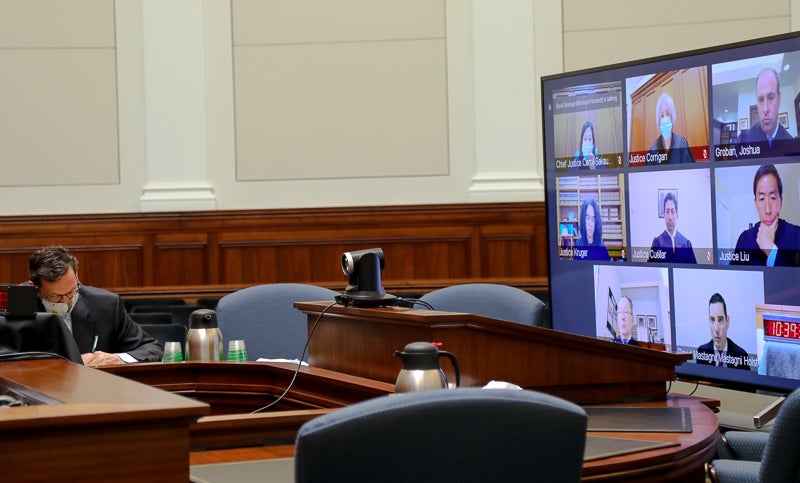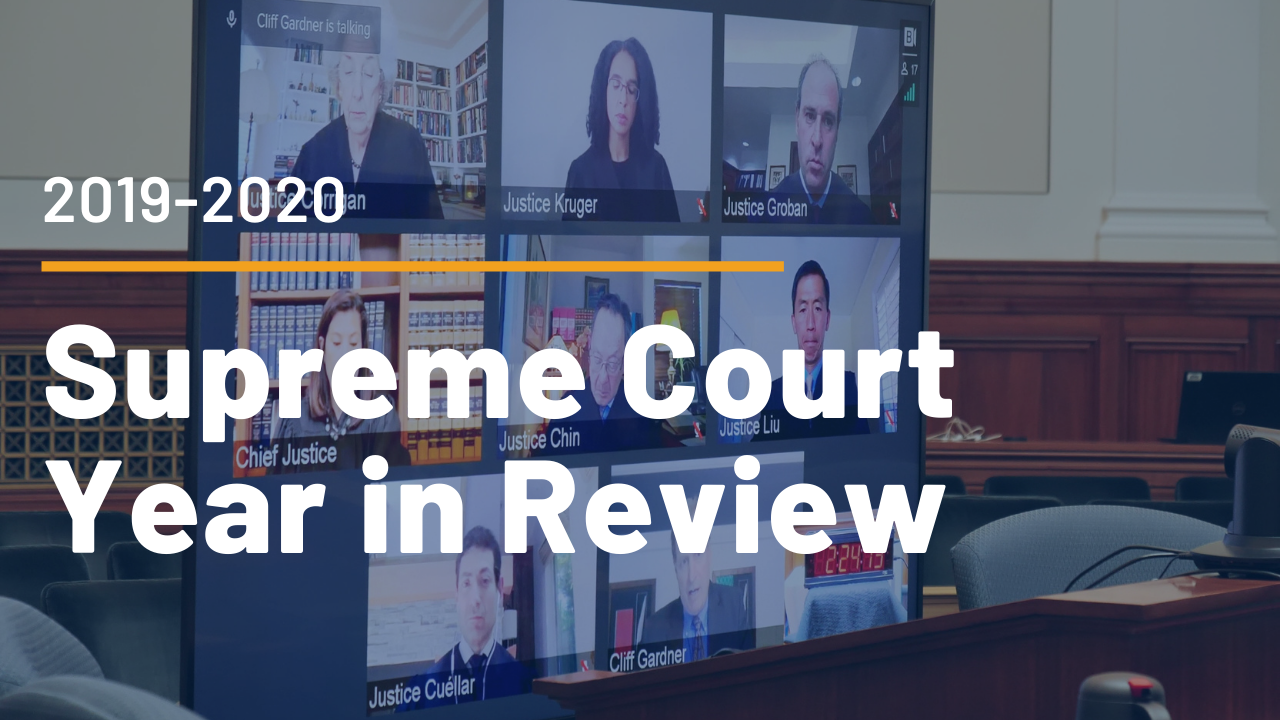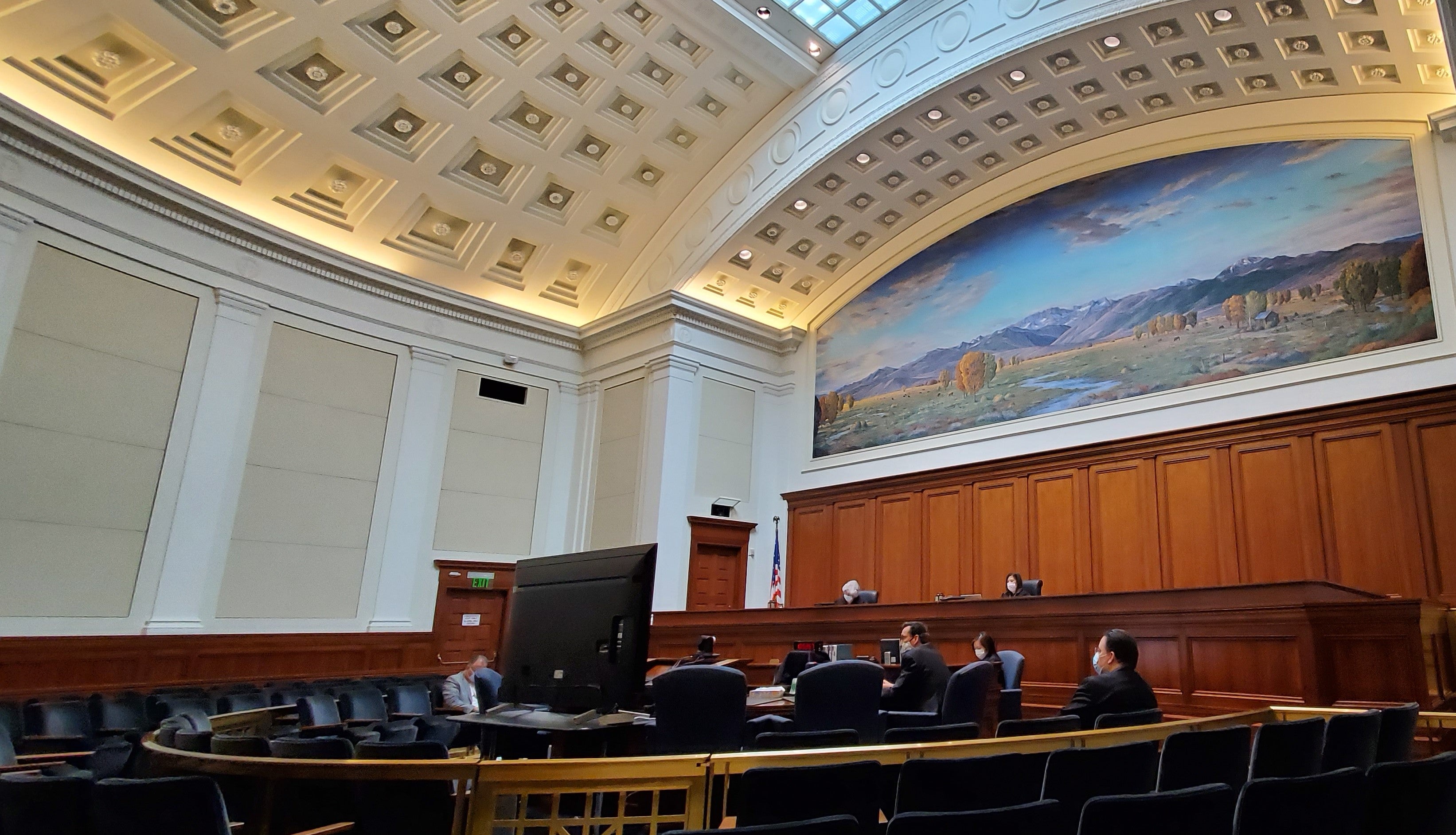
Year in Review: California Supreme Court
In 2020, the California Supreme Court joined Twitter. Follow @CASupremeCourt for real-time opinions and news.
COVID-19: A New Normal
The COVID-19 pandemic brought unprecedented changes to the state judiciary. For the California Supreme Court, one of the most significant transformations was hearing oral argument remotely for the first time in its history.
The court in April hosted its first oral argument by videoconference, allowing justices and attorneys to participate safely from their homes or offices. (The court has webcast oral arguments live, with English and Spanish captioning, since 2016.)
In less than a month, Supreme Court Clerk/Executive Officer Jorge Navarrete and his staff, along with a Judicial Council IT team, had the court up and running on the new virtual platform and hosted a “dry run” with justices and counsel to ensure oral argument ran smoothly.
The court also implemented other changes to conventional practices in response to the pandemic—including temporarily extending filing deadlines and making electronic filing mandatory in all cases except those involving self-represented litigants. The court had first launched mandatory electronic filing for several case types in 2017, a transition that allowed the court to rapidly scale up during the pandemic.
See behind the scenes as the court unveiled virtual oral argument:
Justice Ming Chin Retires
The court saw a major change to its bench when Ming W. Chin, its longest serving sitting justice, retired on August 31. During Justice Ming Chin’s nearly 25 years on the high court, he authored more than 350 majority opinions and more than 100 separate opinions.
Justice Chin penned landmark decisions in areas such as DNA, toxic tort insurance coverage, surrogate parenting, spousal abuse, and hate crimes.
He also played a significant role on California’s Judicial Council and chaired the council’s technology advisory committee for 10 years, promoting advances that have helped the judicial branch address challenges presented by the COVID-19 epidemic.
He has been an avid proponent of continuing education for lawyers and judges, increasing diversity within the legal profession, preserving judicial independence, and addressing bias within the legal system. He is a frequent lecturer on these, and other topics, to groups around the world, and has gained global recognition as an expert on DNA evidence and employment law.
Watch the virtual tribute given by Justice Chin’s colleagues during his last oral argument:
The Work of the Court
The California Supreme Court issued 77 majority written opinions during the September 2019–August 2020 court year (see "High-Profile Cases" below).
The court considered 6,455 filings, including 3,682 petitions for review from California’s six appellate court districts.
The court acted on an average of 170 matters at each petition conference, typically held three times each month. Amid the COVID-19 pandemic, the justices have held these meetings by conference call.
Major Changes to California Bar Exam
The global health crisis scuttled plans for thousands planning to take the California Bar Exam in July. In announcing plans instead for an October test administered online, the court also made a permanent reduction to the passing score.
The court further directed the State Bar to expedite creation of a supervised provisional licensing program for 2020 law school graduates—effective until they can take and pass a California Bar Exam. The provisional license will expire no later than June 1, 2022.
In making these changes the court acknowledged: "The changing circumstances surrounding the ongoing COVID-19 pandemic in California, and throughout the country, have had an unprecedented impact on professional licensure testing for graduates seeking admission to many professions." The court recognized that "[m]any law school graduates are being substantially affected by the resulting disruption."
Jury Workgroup Launched
In January, the court announced it would form a new Jury Selection Work Group. The court charged the work group with assessing possible reforms to guard against impermissible discrimination in jury selection and better ensure juries represent a cross-section of their communities.
In July, the court tapped 11 judges and justices for the work group. Five attorneys also serve as advisory members.
The court also joined the national conversation concerning racial justice by issuing a public statement acknowledging the “legacy of past injustices inflicted on African Americans persists powerfully and tragically to this day.” The justices further wrote:
In our profession and in our daily lives, we must confront the injustices that have led millions to call for a justice system that works fairly for everyone. . . . Each member of this court, along with the court as a whole, embraces this obligation."
High-Profile Cases
- The court unanimously invalidated legislation that sought to exclude candidates in presidential or gubernatorial primary elections from the California ballot unless they disclose five years of income tax returns (Patterson v. Padilla).
- In a case regarding public employee pension benefits, the court unanimously upheld restrictions on “pension spiking” practices. But it left intact the “California Rule,” which generally entitles public workers to pension benefits in effect when they were hired, and to other benefits added before retirement, unless reductions are offset by additional benefits (Alameda County Deputy Sheriff’s Association v. Alameda County Employees’ Retirement Association).
- The court unanimously reversed the death penalty sentence, but affirmed the guilty conviction, in People v. Peterson. The court held the trial judge improperly dismissed jurors who said they personally disagreed with the death penalty but would be willing to impose it.
- The court ordered part of a landmark Court of Appeal bail ruling to become binding authority, compelling judges to consider, when setting bail, a defendant’s ability to pay as well as nonfinancial conditions of release such as electronic monitoring. The Court of Appeal’s decision in In re Humphrey is pending review by the Supreme Court.
- In light of anticipated federal delay in producing census data on which each state’s electoral maps are based, the court granted emergency relief extending constitutional and statutory deadlines for the state Citizens Redistricting Commission to submit congressional and state legislative maps for the 2022 election (Legislature v. Padilla).
- In Abbott Laboratories v. Superior Court, the court expanded the type of relief that county district attorneys can obtain on behalf of California consumers, allowing not only statewide injunctions under California’s unfair competition law, but also civil penalties for violations occurring outside the district attorney’s county.
- The court considered and denied several emergency petitions related to the COVID-19 pandemic, including:
- A petition that sought to block $75 million in state disaster funds for undocumented immigrants affected by COVID-19—the court denied relief, and allowed the challenged funding, in Benitez v. Newsom.
- Two petitions by public and private schools seeking to resume in-person teaching despite state and local health orders—the court denied relief in Immanuel Schools and Orange County Board of Education v. Newsom.
- A petition seeking substantial reduction of youth populations in juvenile halls—the court directed expedited hearings before the Los Angeles Superior Court in All Youth Detained in Juvenile Halls and Camps in Los Angeles County v. Superior Court.
- A petition seeking release of detainees in California jails and juvenile facilities, the court denied relief in National Association of Criminal Defense Lawyers v. Newsom, observing that such claims are best filed first in local superior courts, which can give “prompt attention in a manner that considers the diversity of local conditions throughout the state.”
- A petition that sought to block $75 million in state disaster funds for undocumented immigrants affected by COVID-19—the court denied relief, and allowed the challenged funding, in Benitez v. Newsom.
Summary of Key Court Year Statistics
[September 1, 2019– August 31, 2020]
|
Action/Category |
Number |
|---|---|
| Opinions | 77 |
| Civil Cases | 38 |
| Criminal Cases | 22 |
| Death Penalty Cases | 17 |
| Filings | 6,455 |
| Petitions for Review | 3,682 |
| Civil Appeals & Writs | 1,000 |
| Criminal Appeals & Writs | 2,679 |
| Death Penalty Appeals & Writs | 3 |
| Original Proceedings | 2,773 |
| Civil Writs & Other Matters | 208 |
| Criminal Writs & Other Matters | 1,803 |
| Executive Clemency | 26 |
| Death Penalty Appeals & Writs | 8 |
| Death Penalty Habeas Corpus | 19 |
| State Bar Matters | 709 |
| Dispositions | 6,558 |
| Petitions for Review | 3,738 |
| Civil Appeals & Writs | 1,003 |
| Criminal Appeals & Writs | 2,730 |
| Death Penalty Appeals & Writs | 5 |
| Original Proceedings | 2,820 |
| Civil Writs & Other Matters | 218 |
| Criminal Writs & Other Matters | 1,837 |
| Executive Clemency | 13 |
| Death Penalty Habeas Corpus | 27 |
| Death Penalty Habeas Corpus [Transferred] | 19 |
| State Bar Matters | 706 |
| Death Penalty Habeas Corpus Matters to Show Cause | 6 |
| Court of Appeal Opinions Ordered Published | 0 |
| Court of Appeal Opinions Ordered Depublished | 28 |





